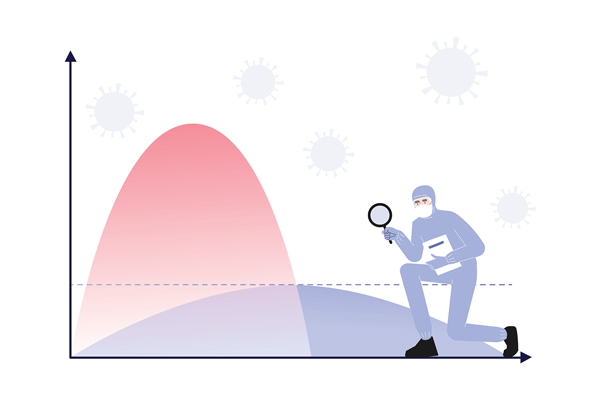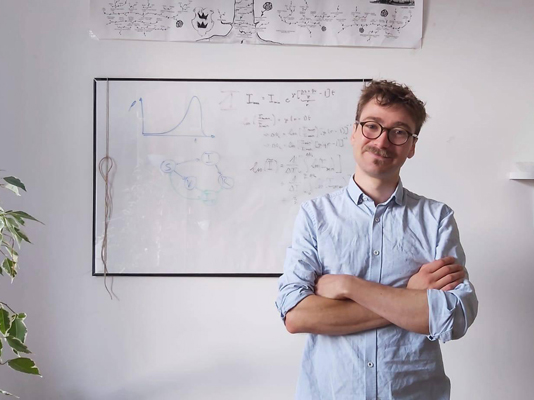August 4, 2021
Counterintuitive Dynamics Threaten the End of the Pandemic
Scientists model the factors influencing the risk of creating a vaccine-resistant virus strain

While vaccination campaigns against the coronavirus promise to end the pandemic, scientists raise concerns about creating an environment that allows vaccine-resistant strains of the virus to thrive. An international team of researchers around Simon Rella created a model in which, at the very end of the vaccination campaign, the risk of a vaccine-resistant virus becoming dominant increases dramatically. Their findings are now being published in Nature Scientific Reports.
Understanding the dynamics of a complex and global phenomenon like the coronavirus pandemic is hardly an easy task. Scientists combine tools from epidemiology – the study of how diseases spread – and population genetics – looking into the spread of genetic traits – to create mathematical models that describe the pandemic.
Simon Rella, researcher at the Institute of Science and Technology (IST) Austria, in collaboration with economist Yuliya Kulikova, Banco de España, geneticist Emmanouil Dermitzakis, University of Geneva Medical School, and Fyodor Kondrashov, IST Austria, constructed such a model of the pandemic to study the emergence of vaccine-resistant strains. The scientists’ findings indicate that the vaccination alone may not be enough to quell vaccine resistance in the virus and that more countermeasures are required.
A Virtual Pandemic
“The coronavirus always mutates in tiny ways,” Simon Rella, first author of the new study, explains. “Some rare mutations could possibly lead to resistance against existing vaccinations, but many of those cannot effectively spread in the population.”
In their computer model, the scientists simulated a population of ten million people living in a pandemic with characteristics similar to the real one. There are infected and sick people, cured and vaccinated people, and others still susceptible to the virus. If the number of infected people rises above a set threshold, containment measures are put in place and the rate of new infections drops – just like in the real world.
“We simulated the mutated, vaccine-resistant virus and its initial spread occurring randomly,” Rella continues. “This is a realistic approach, because in reality there is a myriad of factors determining whether this new virus strain can spread: Am I isolating while being sick? How susceptible are people I am in contact with? And many more.”
The scientists then studied the epidemiological factors influencing the risk of a new vaccine-resistant strain becoming the dominant form of the virus rendering the vaccination less or completely ineffective.

Additional Measures Needed
“If there are many people infected with the original strain of the virus, there are plenty of opportunities for the virus to mutate in any of those bodies. This increases the chance of a vaccine-resistant strain occurring,” Rella cautions. Similarly, if the vaccination campaign is going slowly, the virus has more time to mutate and the risk also increases.
“But we also found a counterintuitive result: At the end of a vaccination campaign, when a lot of people are already vaccinated and there are still a lot of other people infected with the original virus, a vaccine-resistant strain not only has a higher chance to occur but also an evolutionary advantage against the original strain,” he points out.
The new virus strain is less or not at all hindered by the vaccination while to original one cannot reproduce in vaccinated people. In this scenario, where there are many vaccinated as well as still infected people, this is an advantage for the new strain. It can easily spread among the vaccinated population.
The scientists consider this point in the pandemic as critical. Additional non-pharmaceutical measures like frequent testing, contact tracing, and travel restrictions may be needed to lower the risk of a vaccine-resistant virus strain emerging and becoming dominant. These measures could reduce the overall spread of the virus and quickly lower the number of infected people, therefore lowering the chances for the virus to mutate. “Understanding these counterintuitive dynamics may be crucial to defeat the pandemic,” says Rella.
Publication
Rella, S.A., Kulikova, Y.A., Dermitzakis, E.T. et al. Rates of SARS-CoV-2 transmission and vaccination impact the fate of vaccine-resistant strains. Sci Rep 11, 15729 (2021). https://doi.org/10.1038/s41598-021-95025-3
Funding information
ETM is supported by the Swiss National Science and Louis Jeantet Foundation. The work of FAK was in part supported by the ERC Consolidator grant (771209—CharFL).



